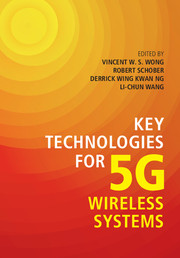Book contents
- Frontmatter
- Contents
- List of Contributors
- Preface
- 1 Overview of New Technologies for 5G Systems
- Part I Communication Network Architectures for 5G Systems
- Part II Physical Layer Communication Techniques
- Part III Network Protocols, Algorithms, and Design
- 15 Massive MIMO Scheduling Protocols
- 16 Mobile Data Offloading for Heterogeneous Wireless Networks
- 17 Cellular 5G Access for Massive Internet of Things
- 18 Medium Access Control, Resource Management, and Congestion Control for M2M Systems
- 19 Energy-Harvesting Based D2D Communication in Heterogeneous Networks
- 20 LTE-Unlicensed: Overview and Distributed Coexistence Design
- 21 Scheduling for Millimeter Wave Networks
- 22 Smart Data Pricing in 5G Systems
- Index
- References
15 - Massive MIMO Scheduling Protocols
from Part III - Network Protocols, Algorithms, and Design
Published online by Cambridge University Press: 28 April 2017
- Frontmatter
- Contents
- List of Contributors
- Preface
- 1 Overview of New Technologies for 5G Systems
- Part I Communication Network Architectures for 5G Systems
- Part II Physical Layer Communication Techniques
- Part III Network Protocols, Algorithms, and Design
- 15 Massive MIMO Scheduling Protocols
- 16 Mobile Data Offloading for Heterogeneous Wireless Networks
- 17 Cellular 5G Access for Massive Internet of Things
- 18 Medium Access Control, Resource Management, and Congestion Control for M2M Systems
- 19 Energy-Harvesting Based D2D Communication in Heterogeneous Networks
- 20 LTE-Unlicensed: Overview and Distributed Coexistence Design
- 21 Scheduling for Millimeter Wave Networks
- 22 Smart Data Pricing in 5G Systems
- Index
- References
Summary
In this chapter, we present a general approach to data-oriented downlink scheduling in a wireless network, possibly formed from multiple base stations and users. Following commonly used acronyms, base stations will be denoted by “BS” (base station) and user devices by “UE” (user equipment). Specifically, we consider the case where the BSs have a large number of antennas and serve a given number of downlink data streams using multiuser multiple-input multiple-output (MIMO) spatial multiplexing. When the number of antennas is large and is significantly larger than the number of downlink data streams, such systems are referred to as “massive MIMO.” As we shall see, a network operating in the massive MIMO regime has several advantages, not only in terms of achievable spectral efficiency per cell but also in terms of simplified signal processing, rate allocation, and user scheduling. This nontrivial system simplification is due to the fact that the large number of antennas and not-so-large number of simultaneously transmitted data streams has the consequence that the signal-to-interference-plus-noise ratio (SINR) at each UE becomes an almost deterministic quantity that depends only on the distance-dependent path loss and large-scale fading (shadowing) of the propagation channel between the UE and the serving BS, and not on the small-scale multipath fading. Since distance-dependent path loss and shadowing are relatively slowly varying in time and frequency nonselective, in contrast to the time- and frequency-selective small-scale fading, it follows that the scheduling protocol can learn quite accurately the rate at which each user can be served from each BS. Based on this knowledge, a scheduling protocol can decide dynamically which subset of users should be served from which BS. In this chapter, we will see how such a dynamic scheduling policy with given optimality performance guarantees can be systematically designed.
Introduction
Wireless data traffic has grown dramatically in recent years. Unlike traditional voice-oriented interactive communications, wireless data is typically asymmetric (the downlink traffic is much higher than the uplink traffic) and more delay tolerant. For example, a typical killer application is represented by on-demand video streaming, which is predicted to account for 75% of the total mobile data traffic by 2019 [1]. The streaming process requires that video frames arrive at the receiver within their playback deadlines.
Information
- Type
- Chapter
- Information
- Key Technologies for 5G Wireless Systems , pp. 335 - 357Publisher: Cambridge University PressPrint publication year: 2017
References
Accessibility standard: Unknown
Why this information is here
This section outlines the accessibility features of this content - including support for screen readers, full keyboard navigation and high-contrast display options. This may not be relevant for you.Accessibility Information
- 1
- Cited by
